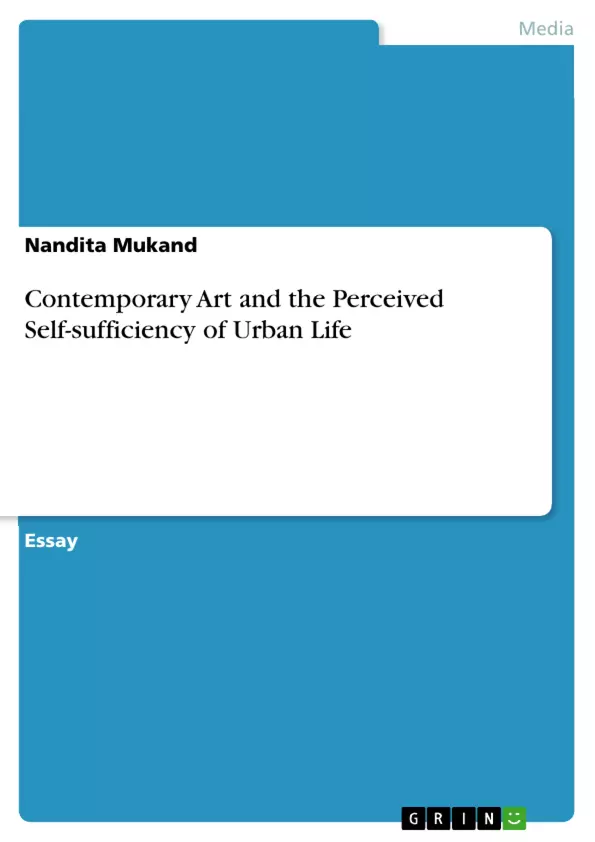Seventeenth century scientists (Descartes, Bacon, and Newton) made discoveries that brought us scientific method and a vision of secular progress through technological achievement. But in this vision the purpose of knowledge was proposed as utilitarian, the domination of nature. The world we live in today is based on this vision of technological achievement.
Art, because it is not shackled by the purposes of science, has an important role to play in enhancing our awareness of the true nature of things. Its negotiations with the natural world are intuitive and imaginative and this can enable it to bring to light much that is concealed from our everyday perception.
Inhaltsverzeichnis (Table of Contents)
- Contemporary Art and the Perceived Self-sufficiency of Urban Life
- Walter De Maria, The New York Earth Room
- City life today is lived largely indoors with a lot of involvement in non-physical worlds
- Similarly, Walter de Maria's Earth Room (1977, earth, Dia Art Foundation, New York)
- City dwellers often get their ideas about nature from video footage in blockbuster movies
- Works such as these remind us that nature is not just a pretty picture to be looked at.
- Contemporary science too supports a more holistic understanding of our relationship with nature.
- Art, because it is not shackled by the purposes of science, has an important role to play in enhancing our awareness of the true nature of things.
- Artists, through the format of landscape painting have always tried to comprehend the 'nature of what is perceived.
- The Arte Povera movement (started in Italy in the late 1960s) was concerned with the point at which nature and culture intersect.
- Artists today are still interested in this direct experience of nature. Giuseppe Penone talks about how “the subject must gain contact with the world through the relationship of his own body to natural processes”
- Hamish Fulton, Song Path (from Ten Toes Towards the Rainbow)
- Chris Drury, Time Capsule
- However this genre of work harks back to a Romantic tradition of escaping from the real world.
- Yoshihiro Suda, Weeds
Zielsetzung und Themenschwerpunkte (Objectives and Key Themes)
This work explores the relationship between contemporary art and the perceived self-sufficiency of urban life. It examines how artists are responding to the increasing disconnect between humans and nature in a world dominated by technology and urban environments. The text highlights the ways in which artists are using materials and processes to reconnect with the natural world and challenge traditional views of nature and culture.
- The impact of urbanization and technology on our relationship with nature
- The role of art in fostering a more holistic understanding of nature
- The significance of materials and processes in artistic expression
- The interplay between nature and culture in contemporary art
- The use of art as a means to reconnect with the natural world
Zusammenfassung der Kapitel (Chapter Summaries)
The text begins by discussing the influence of seventeenth-century scientific discoveries on our understanding of nature and technology. It then explores the implications of urban life on our perception of the natural world, citing Rebecca Solnit's work as an example. The author then delves into specific artworks, such as Walter De Maria's Earth Room, which challenge our assumptions about nature and its significance in our lives.
The text moves on to examine how artists are using different mediums and approaches to engage with the natural world, highlighting the importance of direct experience and the rejection of traditional representation. It explores the work of artists such as Giuseppe Penone, Hamish Fulton, and Chris Drury, who are all using their art to connect with nature in different ways.
The author then discusses the challenges of forging a connection with nature within the urban environment, focusing on the work of artists such as Yoshihiro Suda, who use their art to highlight the beauty and significance of the natural world even in the most urbanized settings.
Schlüsselwörter (Keywords)
The key themes and concepts explored in this text include: contemporary art, urban life, nature, technology, materiality, process, representation, direct experience, environmental awareness, and the relationship between humans and nature. The work also delves into specific artistic movements and artists such as Arte Povera, Giuseppe Penone, Hamish Fulton, Chris Drury, and Yoshihiro Suda, highlighting their contributions to the ongoing dialogue between art and the natural world.
- Arbeit zitieren
- Nandita Mukand (Autor:in), 2013, Contemporary Art and the Perceived Self-sufficiency of Urban Life, München, GRIN Verlag, https://www.grin.com/document/298497



